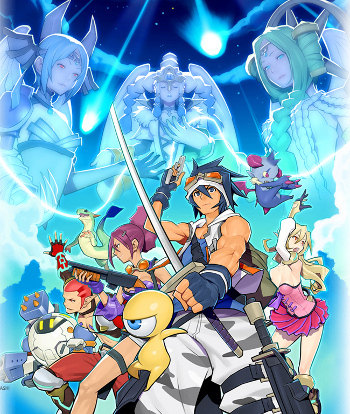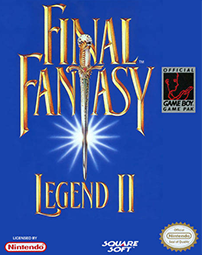Part 2 of my examination of SaGa 2 !
***
Well I promised you a bit more SaGa 2, and I am a man of my word! So let's get into the meat of this thing, shall we?
SaGa 2: Hihou Densetsu – Goddess of Destiny is a DS remake of a Game Boy game released in Japan in 1990 and in 1991 in the US as Final Fantasy Legend II. The new version of the game was released to Japanese audiences in 2009 in order to coincide with the 20th anniversary of the SaGa series. Unfortunately, the remake never made it state-side.

Lucky for all of us, the brave and beautiful folks over at Crimson Nocturnal took it upon themselves to do a full English translation of the game and put out a free patch for the internet at large. Hooray! Now there's a reason to import the title other than to practice your Japanese!
The effort to put the patch into practice was well worth it, in my opinion.
The core of the gameplay is essentially intact. The character creation system still revolves around four different character types: Human, Esper (previously called Mutant), Mecha, and Monster. The Humans are pretty much your jack-of-all-trades characters. They develop at a steady pace, and can use any and all weapons with a relatively average proficiency. The Espers develop at a slightly slower rate then their Human counterparts, but are innately more powerful when using magic-based attacks. Espers also have the potential to spontaneously develop spells and abilities that are rechargeable when your party stays at an Inn. Unlike Humans and Espers, Mechas don't develop by using items repetitively in order to strengthen stats. Mecha's stats are determined by the equipment that they have allocated to them, and, while the item's durability is cut in half when equipped to a Mecha, all items become rechargeable. Monsters can't equip any items or weapons, and they don't improve stats by fighting. Monsters grow in strength by eating the meat of the enemies you defeat, and then transforming into (hopefully) bigger and badder forms.
The story is also basically untouched, though the localization that the Crimson Nocturnal team has done is significantly more US friendly than the original translation. The graphical overhaul has really served to put flesh on the bones of the world that players enjoyed back in the early 90s. The environments are vibrant and distinct, and the character creation screen has multiple customization options instead of just providing a single standard form determined by character type.
My faithful favorite signature of the series has also come back in full force: the meat eating. The DS version does the player a favor however, by adding a Meat Dictionary (there's a joke there somewhere...) to the Main Menu screen for easy reference of the transformations that you've already put your teammates through. As nice as this additional feature is, it's not implemented as well as it could have been. You effectively have to take the risk of the transformation and then restart the game if you want to consult the Dictionary. Not real helpful in practice, but a fun additional tool nonetheless.
In addition to this tweak to the Meat Mechanics (again, there HAS TO be a joke there...), there are some totally new additions to the battle mechanics.
Random battles have gone the way of the dinosaur, replaced instead by visible enemies that give chase to your party on the world map and in dungeons. If you're trying to evade your pursuers, and you happen to have more than one in tow, you'll trigger a Chain Battle if you get caught. Your party then has to weather multiple waves of enemies, which can really put a dent in your dungeon supplies.
Muses are the biggest change to the world of SaGa 2. Muses are mystical servants of the titular “Goddess of Destiny”, and have a variety of roles to play. Each Muse is met while traveling in dungeons or in towns, and a cutscene and mini-quest will, if you pursue some pretty straightforward clues, lead your party into a friendship with the Muse at hand. Your party is then rewarded with a chunk of MP (Magic or Muse Points, I have no idea...). After befriending the Muse, they will occasionally reward you with more MP at the end of battles if you've used strategies that the Muse prefers to route your enemies.
These points can be used to purchase Threads of Fate from the Goddess herself. These special items have names like “Love”, “Loner”, “Family”, and “Rival”. Using these attacks in battle chain together and increase the damage dealt by your party. Depending on what Thread you use to link your character's attacks, the relationship between those two characters changes. These party dynamics help to color cutscenes throughout the story, helping to give your adventure a bit more color as you pursue the main storyline.
Overall, this DS game is a truly worthwhile overhaul of a classic Game Boy RPG. I highly recommend going the extra mile to patch an import copy of this game and give it a whirl. The story is fun, the battle mechanics have some great additions, and the character customization is very strong.
What am I forgetting...OH! The music! I won't waste more space gushing about the great job that SquareEnix did with giving the audio a facelift. I don't have the vocabulary to do it justice. I'll let a side by side of the title screen music, old and new, speak for itself.

Log in to comment